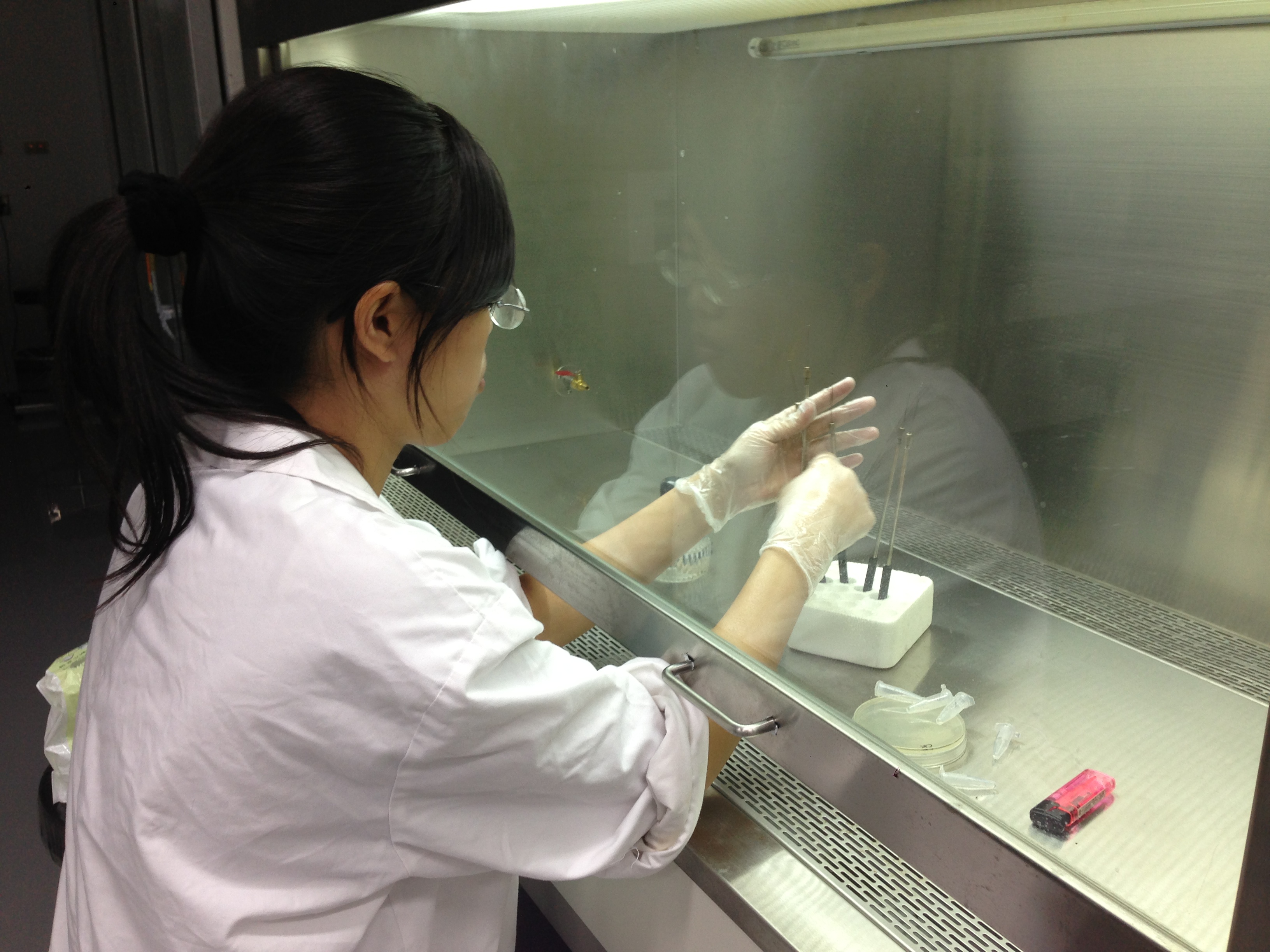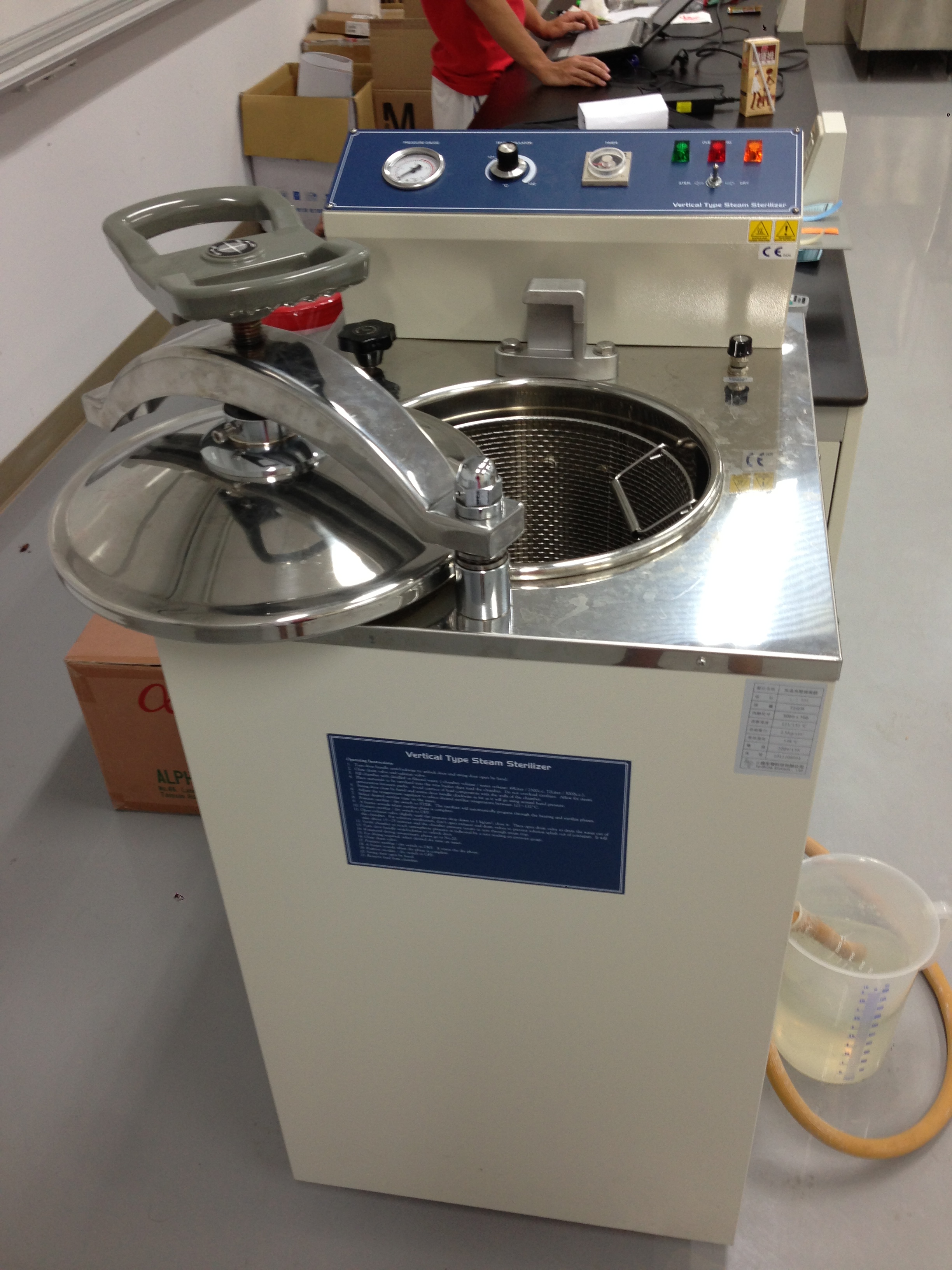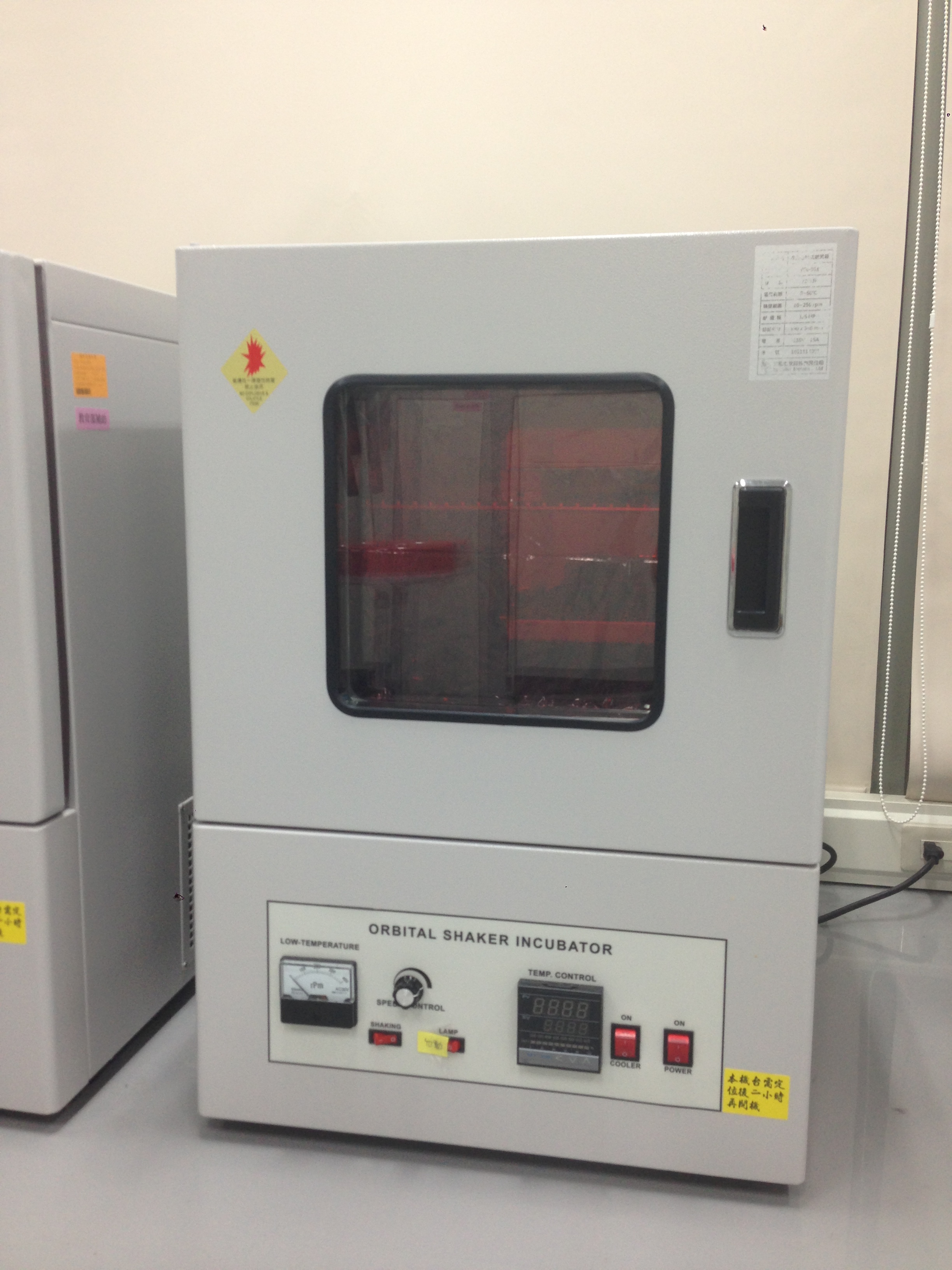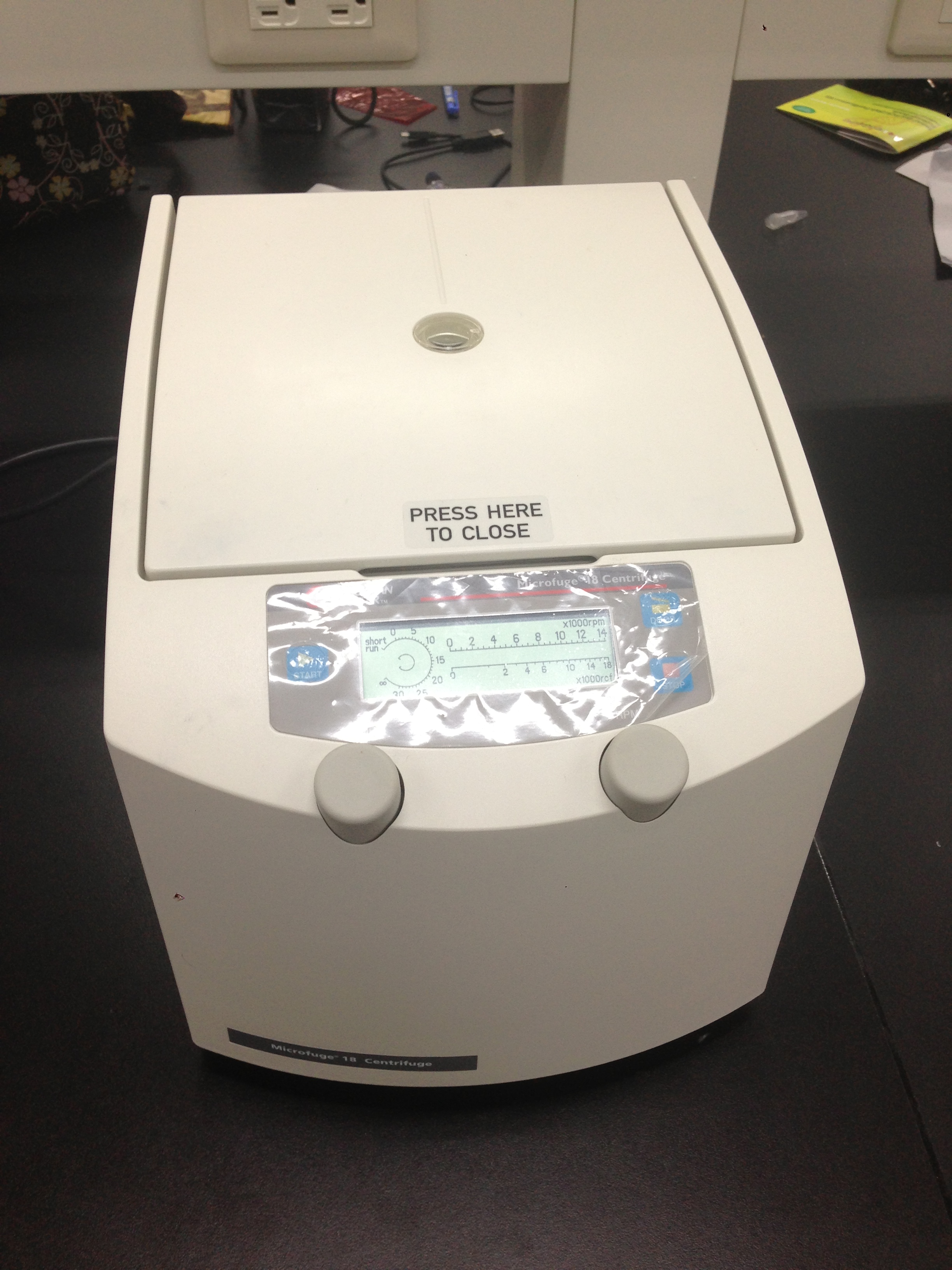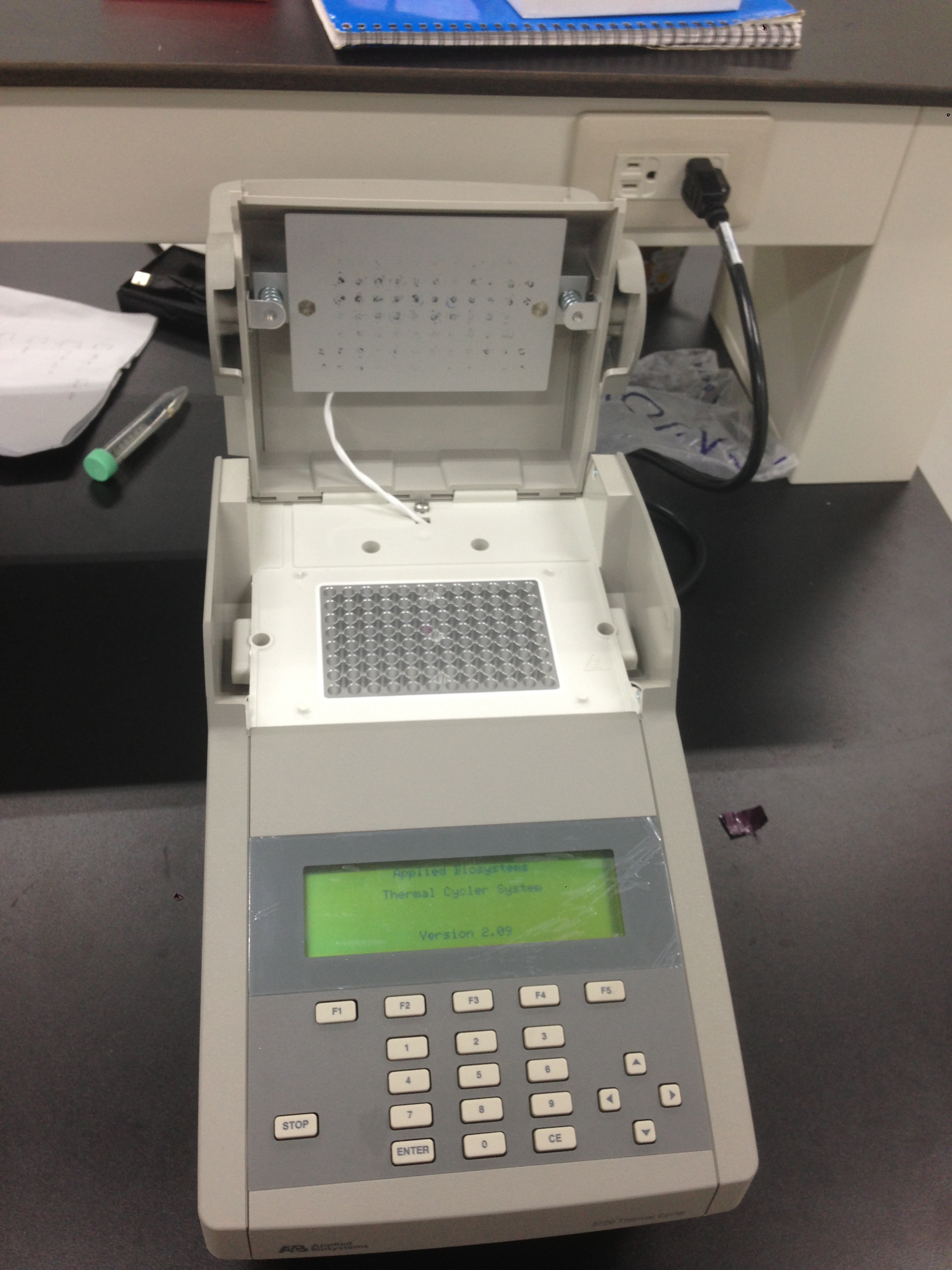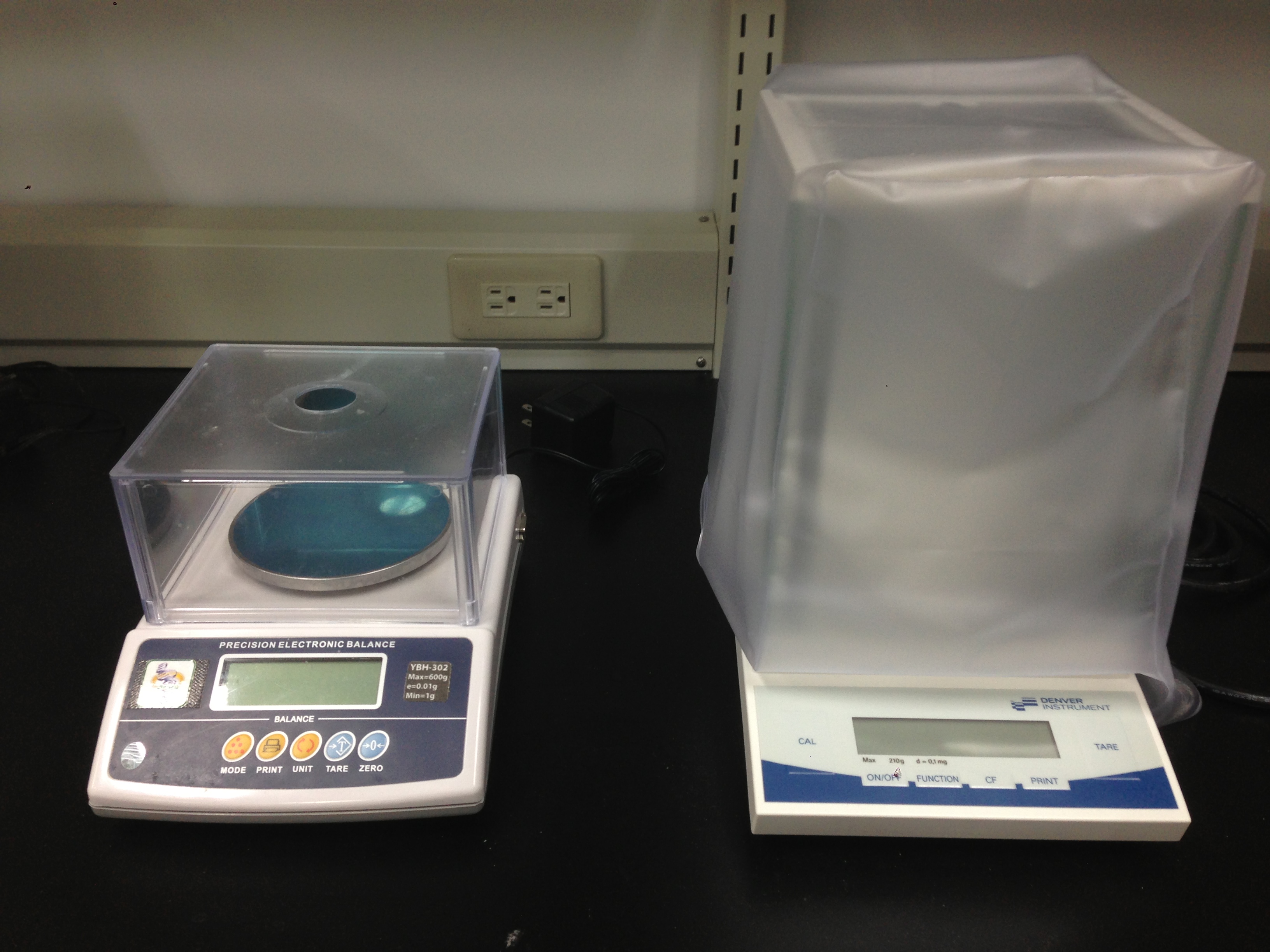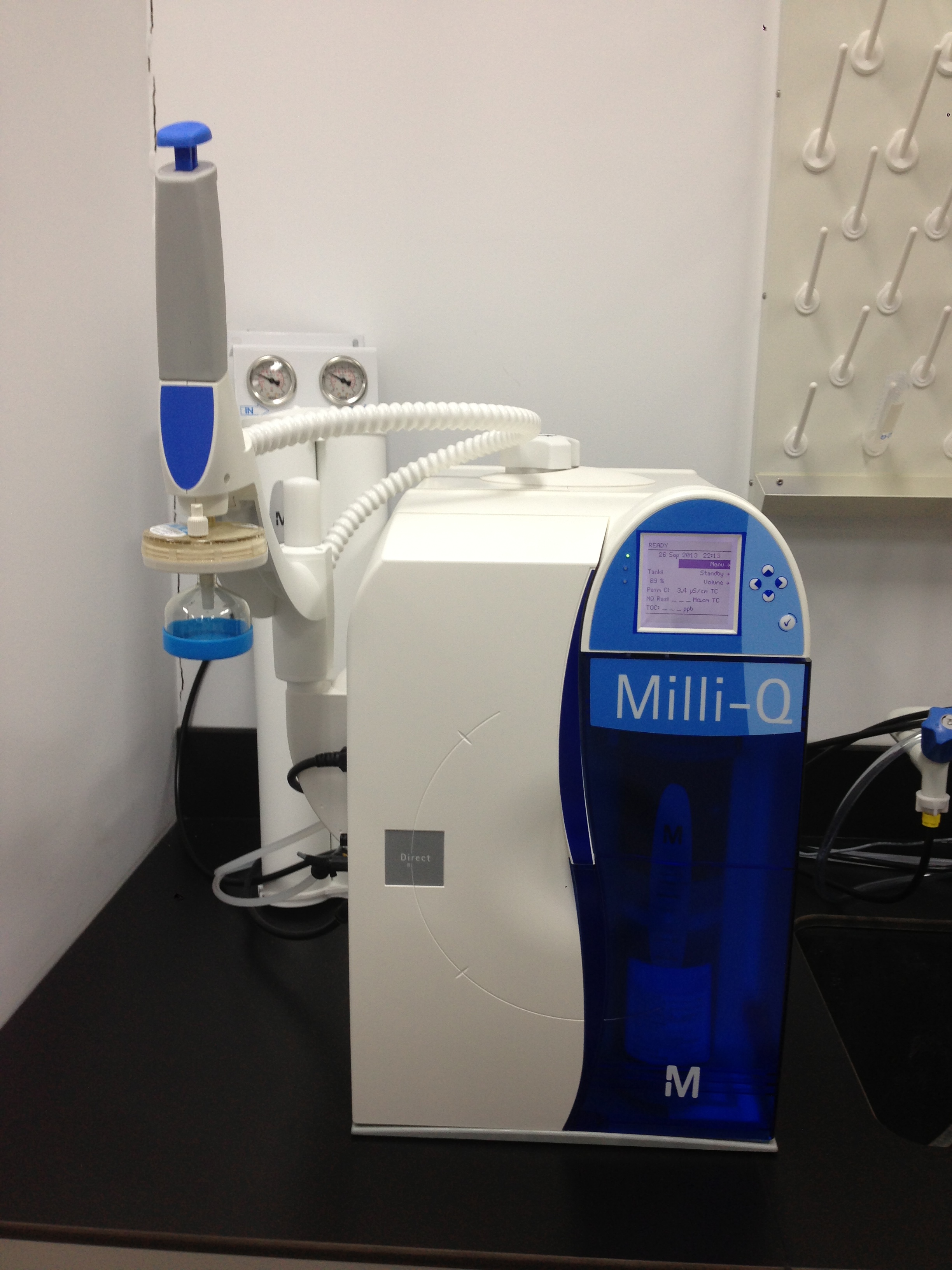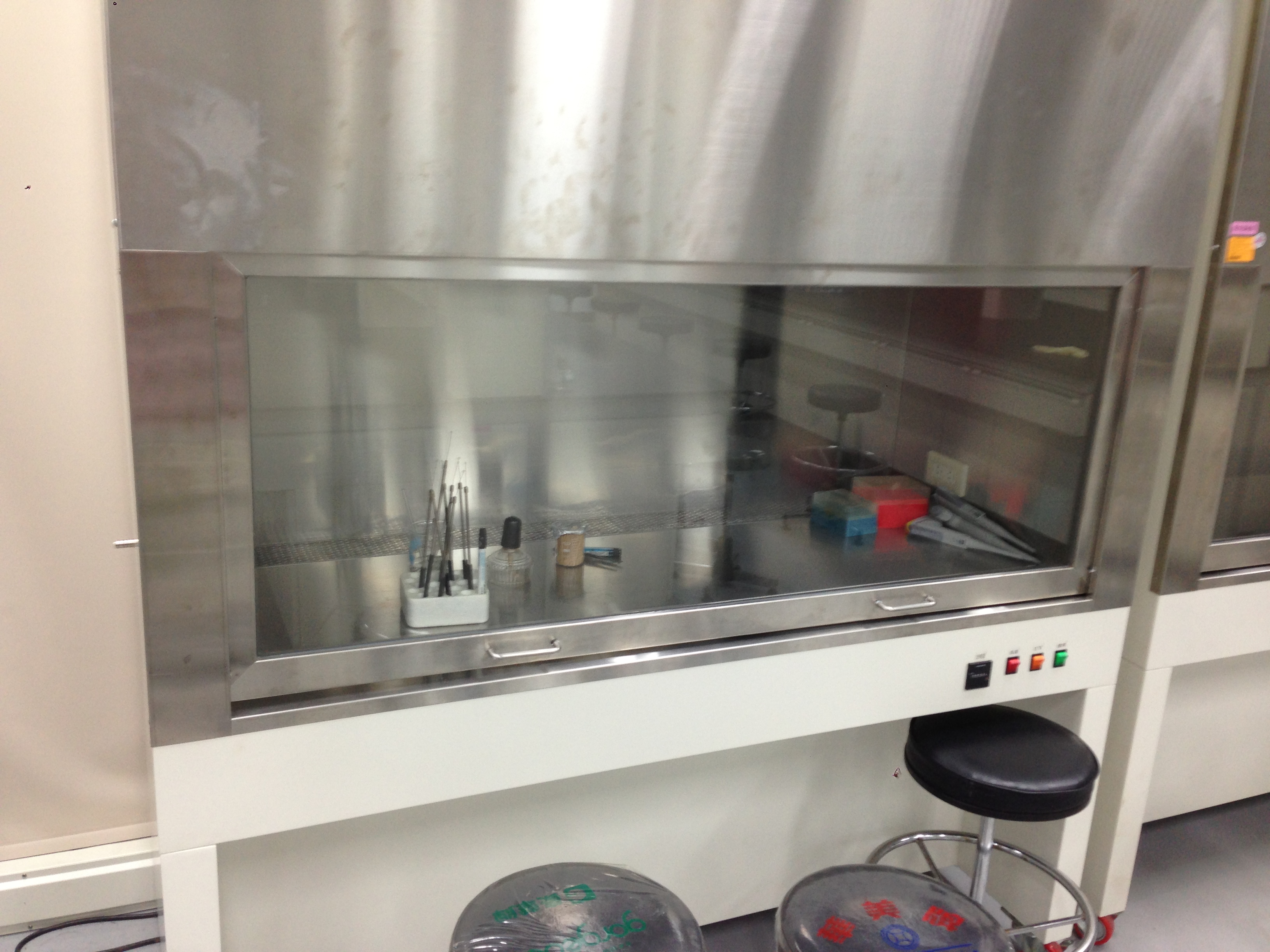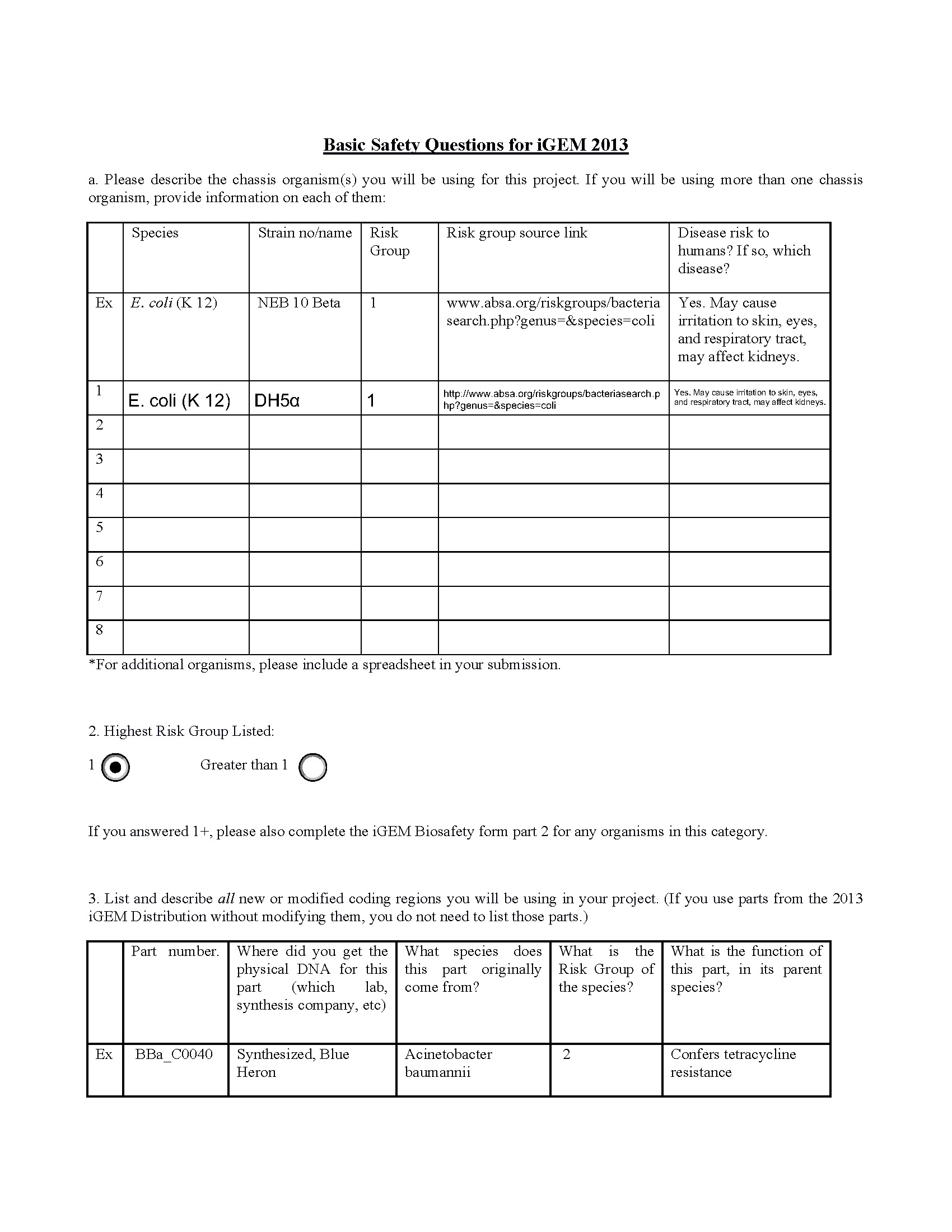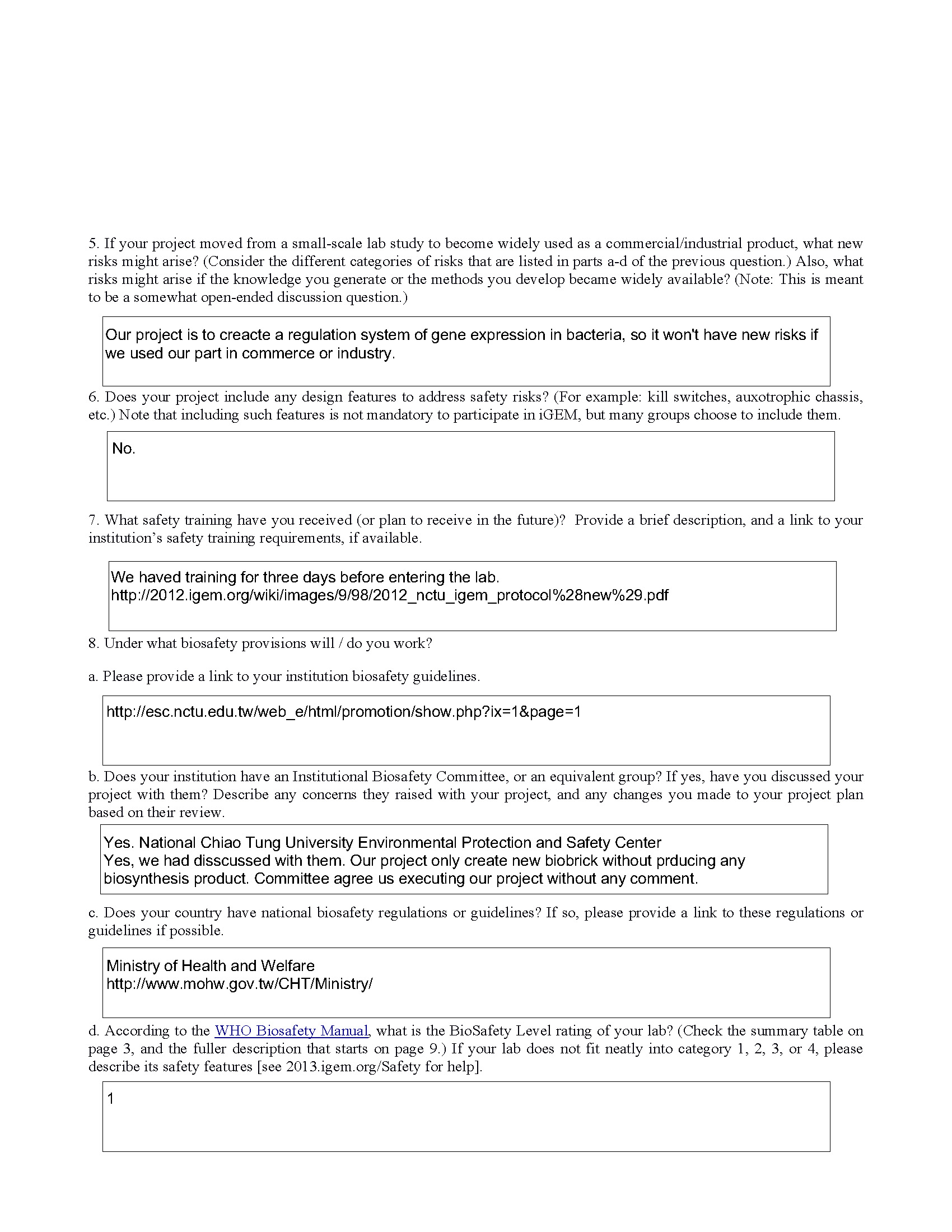Team:NCTU Formosa/safety
From 2013.igem.org
Inside a newly built, well-equipped laboratory, we conducted our experiment. Besides safety equipment, each member is well informed of the safety rules and emergency handling.
Contents |
SAFETY OF OUR PROJECT
Our project is to create a regulatory system of gene expression in bacteria, only create new biobrick without producing any biosynthesis product. So it won't have new risks if we used our part in commerce or industry. We had discussed with National Chiao Tung University Environmental Protection and Safety Center.The committee agreed us executing our project without any comment.
ORGANISMS WE USED
| Species | Strain Number | Risk group | Disease risk to human |
|---|---|---|---|
| E.coli | DH5α | 1 | May cause irritation to skin, eyes, and respiratory tract, may affect kidneys. |
NEW OR MODIFIED CODING REGION WE USED
| Part number | Where to get this part | Originally come from | Risk group | Function |
|---|---|---|---|---|
| [http://parts.igem.org/wiki/index.php?title=Part:BBa_K1017301 BBa_K1017301] | addgene | Synechocystis | 1 | chimeric light receptor function of the photoreceptor Cph1 |
| [http://parts.igem.org/wiki/index.php?title=Part:BBa_K1017401 BBa_K1017401] | genedireX | E. coli | 1 | regulating gene expression |
| [http://parts.igem.org/wiki/index.php?title=Part:BBa_K1017402 BBa_K1017402] | genedireX | E. coli | 1 | regulating gene expression |
SAFETY PROCEDURE IN OUR LABORATORY
This year, we use E.coli DH5α, a bacteria that classified under Risk Group 1, as our classis. It's a non-hazardous and non-infective bacteria that generally used in labs and biological experiments. The safety problem of products in the project is also concerned. In our design, E.coli is engineered to produce various fluorescence proteins and some plant hormones, which are harmless to human and environment. Even so, we follow the standard safety procedure to guarantee a safe experiment environment without dangers. To sum up, we have confidence that our project will not raise any biosafety issue.
Researcher's Safety
In order to protect our researchers from infecting engineered organisms and contaminating the samples, we strictly require all the researchers to follow the rules:
- Every participant has read Safety Guidelines for Biosafety Level 1 to Level 3 Laboratory , announced by National Chiao Tung University - Environmental Protection and Safety Center.
- Researchers are fully trained before doing experiments individually. Teaching assistants will guide and supervise the experiments at the first few times.
- Researchers must wear on lab coat and gloves while doing experiment.
- No experiments is allowed to be done outside the laminar flow cabinet, in order to minimize the possibility of releasing Genetically Modified Organisms (GMOs) .
- Before and after conducting experiments, 70% alcohol is applied to sterilize hands, equipments, platform, or anything direct contact E.coli.
- Well designed hazard dealing protocol is applied in all labs in NCTU.
Pubilc Safety
To ensure that the engineered organisms will not leak out and contaminate the environment, all stocks, wastes and cultures which contacted these bacteria should be sterilized, packaged and executed, based on standard decontamination procedures. We also set up a strict door access system, preventing miscellaneous people acquiring E.coli. In fact, E.coli we used in lab is less competitive to wild type, because of the lost of the ability to form biofilms and to thrive in the intestine. As to our product, fluorescent proteins and plant hormones lose their function after autoclaving in high temperature and pressure. So, our project does not raise public safety issues according to above reasons.
Institutional Biosafety Committee
In our university, National Chiao Tung University (NCTU), Environmental Protection and Safety Center (ESC), is strictly responsible for the safety of all labs in the school. What we did in our project follows the rules they announced, and they manage all instruments and chemicals, especially for dangerous and toxic ones. The ESC is supervising our project and our advisors who are in charge of laboratory safety come regularly and check if the rules are fully followed. We started the project only if we got ECS’s permission. In fact, they support our project and think it will not raise any safety issues in terms of researcher, public, and even environment. [http://esc.nctu.edu.tw/web_e/index.php National Chiao Tung University - Environmental Protection and Safety Center (NCTU ESC)]
Instruments in Our Lab
Incubator
The orbital shaker incubator is widely used in microbioloogy labs, cell biology labs, etc. It provides a stationary temperature to cultivate bacteria and cells. Some incubator also have functions to maintain the humility level.
In our lab, the incubator is maintaining the temperature at 37 degrees Celsius, which is the optical temperature of E.coli growing.
Autoclave
The autoclave is used for the safety issue. When sterilzing, the pressure and temperature inside reached high level, forming steam and superheat water. Cells will be killed and proteins will destroyed or denaturalized. Thus, the safety is ensured.
In our lab, every equipment may contact bacteria will be sterilized before and after use to guarantee the safety.
Centrifuge
A centrifuge is a piece of equipment, generally driven by an electric motor, that puts an object in rotation around a fixed axis, applying a force perpendicular to the axis. A centrifuge is also used to separate the components in a mixture. The centrifuge works using the sedimentation principle, where the centripetal acceleration causes denser substances to separate out along the radial direction (the bottom of the tube). By the same token lighter objects will tend to move to the top.1
Thermal cycler
The thermal cycler (also known as a thermocycler, PCR machine or DNA amplifier) is a laboratory apparatus most commonly used to amplify segments of DNA via the polymerase chain reaction (PCR). Thermal cyclers may also be used in laboratories to facilitate other temperature-sensitive reactions, including but not limited to restriction enzyme digestion or rapid diagnostics. The device has a thermal block with holes where tubes holding the reaction mixtures can be inserted. The cycler then raises and lowers the temperature of the block in discrete, pre-programmed steps.2
Balance
An analytical balance is a class of balance designed to measure small mass in the sub-milligram range. The measuring pan of an analytical balance (0.1 mg or better) is inside a transparent enclosure with doors so that dust does not collect and so any air currents in the room do not affect the balance's operation.3
In our lab, we have two models of balance, one is accurate to 0.1g, another is accurate to 0.1mg.
Water purify system
In this system, Water is purified in a first step using unique Jetpore ion-exchange resin, synthetic activated carbon and UV lamp emitting at 185 and 254 nm to reach a resistivity of 18.2 MΩ.cm at 25 °C and a TOC value below 5 ppb, both monitored by advanced analytical techniques.4
The water purify system is used to produce ultra-pure water, which is for experimental use in our lab.
Laminar flow
A laminar flow is an enclosed, ventilated laboratory workspace for safely working with materials contaminated with (or potentially contaminated with) pathogens requiring a defined biosafety level. Several different types of BSC exist, differentiated by the degree of biocontainment required.5
We strictly rule that all researcher should conduct experiments inside the laminar flow.
Reference
- Centrifuge, wikipedia, http://en.wikipedia.org/wiki/Centrifuge
- Thermal cycler ,wikipedia, http://en.wikipedia.org/wiki/Thermal_cycler
- Analytical balance, wikipedia, http://en.wikipedia.org/wiki/Analytical_balance
- Milli-Q Direct, Millipore, http://www.millipore.com/catalogue/module/C85358
- Biosafety cabinet, wikipedia, http://en.wikipedia.org/wiki/Biosafety_cabinet
 "
"
